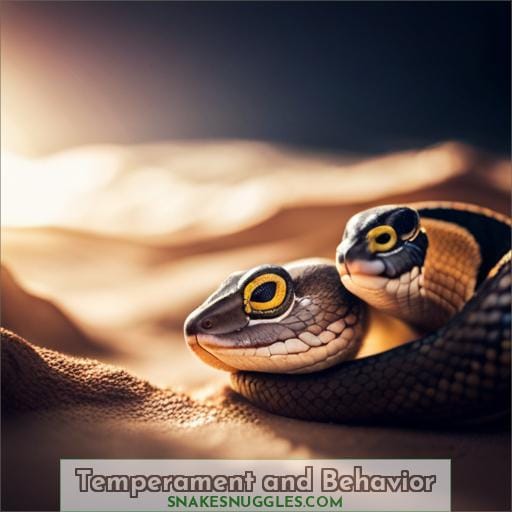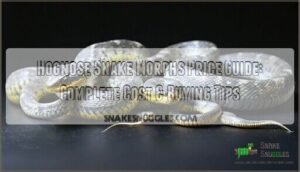This site is supported by our readers. We may earn a commission, at no cost to you, if you purchase through links.
 Imagine you’re considering adding a snake to your collection and want to know which species is better: the rosy boa or the ball python. Look no further! In this article, we will compare these two popular snakes in terms of care, temperament, lifespan, cost considerations, and legal requirements.
Imagine you’re considering adding a snake to your collection and want to know which species is better: the rosy boa or the ball python. Look no further! In this article, we will compare these two popular snakes in terms of care, temperament, lifespan, cost considerations, and legal requirements.
By the end of this read, you’ll have all the information you need to make an informed decision on which snake suits your preferences and lifestyle best.
Table Of Contents
- Key Takeaways
- Care and Maintenance
- Temperament and Behavior
- Individual Differences and Considerations
- Lifespan and Cost Considerations
- Legal Considerations
- Frequently Asked Questions (FAQs)
- Are rosy boas more expensive to care for compared to ball pythons?
- Do ball pythons require more frequent handling than rosy boas?
- Are there any legal restrictions on owning rosy boas or ball pythons?
- How do the lifespans of rosy boas and ball pythons compare?
- Are rosy boas more prone to shedding issues compared to ball pythons?
- Conclusion
Key Takeaways
- Differences in care requirements: Rosy boas have simpler care needs compared to ball pythons, particularly regarding temperature and humidity control.
- Variation in temperament: Rosy boas and ball pythons have different temperament traits, with ball pythons being generally more docile, and rosy boas displaying defensive traits.
- Feeding preferences and stress: There are variations in feeding preferences among snake species, and it is important to identify stress indicators and employ strategies to alleviate stress during feeding.
- Cost and regulatory considerations: Factors such as lifespan, initial purchase costs, long-term maintenance expenses, and compliance with local regulations should be taken into account when comparing rosy boas and ball pythons.
Care and Maintenance
When it comes to care and maintenance, both Rosy Boas and Ball Pythons have specific requirements that need to be met.
- Ball Pythons require precise temperature and humidity control, as well as a slower metabolism compared to other snakes.
- On the other hand, Rosy Boas have similar advantages in terms of care like Corn Snakes but can be thicker-bodied like Ball Pythons.
Understanding these differences is crucial for providing the appropriate care for each species.
Rosy Boas
Taking care of Rosy Boas is relatively straightforward and requires minimal temperature and humidity control, making them an easy choice for beginner snake owners.
- They’re smaller in size compared to ball pythons.
- Rosy boas come in a variety of colors, including shades of brown, orange, and gray.
- Unlike ball pythons, they’ve a generally docile temperament and are less likely to bite.
- Provide them with suitable enclosures that mimic their natural habitat.
- There are different varieties of rosy boas available that vary in appearance.
Ball Pythons
To properly care for ball pythons, you should regularly monitor their temperature and humidity levels.
When it comes to handling challenges, ball pythons may exhibit picky eating habits and potential stress or shedding issues.
Providing environmental enrichment in their enclosure is important to promote mental stimulation and reduce boredom.
Understanding their dietary preferences, such as offering appropriately sized prey items, is crucial for maintaining their health.
Additionally, breeding insights can be gained by researching proper techniques and considering genetic diversity when selecting breeding pairs.
Temperament and Behavior
When considering the temperament and behavior of rosy boas versus ball pythons, it’s important to take into account both comparative opinions and first-hand experiences.
While ball pythons are often perceived as docile, they may exhibit defensive behaviors at times.
On the other hand, corn snakes can be misunderstood but can be docile with proper handling.
Ultimately, your personal preferences and experiences should guide your choice in selecting a snake with a suitable temperament for you.
Comparative Opinions
When comparing the temperament and behavior of Rosy Boas to Ball Pythons, which are known for their generally docile nature and occasional shy defensive behaviors, you’ll find that each species possesses unique characteristics.
-
Handling Preferences:
- Ball pythons are generally perceived as docile but may exhibit defensive behaviors.
- Rosy boas often have a docile temperament.
-
Behavioral Traits:
- Ball pythons can be picky eaters with potential for stress and shedding issues.
- Rosy boas are less likely to bite and have a moderate lifespan.
-
Adoption Experiences:
- Enclosure Design: Consider handling preference and temperament when choosing between these two species
First-Hand Experiences
You’ll often find that ball pythons, when properly handled and cared for, can exhibit docile behavior.
- Handling Techniques: Ball pythons may require more patience and gentle handling to establish trust.
- Habitat Enrichment: Providing hiding spots and climbing structures is important for both species’ mental stimulation.
- Feeding Habits: Both rosy boas and ball pythons require a proper feeding schedule, such as offering one appropriately sized rodent every 7-10 days for adults as part of a rosy boa care routine. Rosy boas are generally good eaters, while ball pythons may be pickier with their food choices.
- Health Monitoring: Regular check-ups with a reptile veterinarian are crucial to ensure the well-being of both snakes.
- Social Interaction: Both snakes benefit from regular social interaction with their owners to build trust and reduce stress.
Individual Differences and Considerations
When considering the individual differences and considerations between rosy boas and ball pythons, it’s important to acknowledge the variations in snake behavior.
Each snake has its own unique temperament, which may influence your decision based on personal preferences and experiences.
Additionally, understanding feeding behavior and potential stress levels can play a role in determining which species is better suited for you as an owner.
By taking these factors into account, you can make a more informed choice when deciding between a rosy boa or ball python as your pet snake.
Acknowledging Variations in Snake Behavior
Keep in mind that individual snakes can display variations in behavior, so it’s important to consider their unique temperaments and preferences when choosing a snake. Behavioral patterns can be influenced by environmental factors such as temperature, humidity, and enclosure setup.
Age-related changes may also impact a snake’s behavior. Additionally, handling techniques play a role in shaping a snake’s temperament over time. Genetic factors can also contribute to behavioral differences between rosy boas and ball pythons.
| Factors | Rosy Boa | Ball Python |
|---|---|---|
| Activity Level | Moderate activity; more exploratory tendencies | Generally low activity; may prefer staying still |
| Temperament | Generally docile with less likelihood of biting | May exhibit defensive behaviors at times |
| Handling Ease | Suitable for frequent handling | Comfortable with human interaction |
| Feeding Behavior | Established feeders are crucial | Minimal pickiness observed |
Considering Personal Preferences and Experiences in Choosing a Snake
Consider your personal preferences and experiences when choosing a snake, as individual differences in behavior can greatly impact your enjoyment and satisfaction with your new reptilian companion.
When making this decision, take into account factors such as:
- Handling preferences, based on how comfortable you’re with different temperaments;
- Personal experiences with snakes in the past;
- Behavioral observations to determine if a particular species aligns well with your desired level of interaction;
- Individual variations that may exist within each species;
- Feeding habits to ensure compatibility between you and your chosen snake.
Understanding Feeding Behavior and Potential Stress
When it comes to understanding the feeding behavior and potential stress of rosy boas and ball pythons, it’s important to recognize that individual snakes may exhibit variations in their preferences and behaviors.
Feeding preferences can vary between species, with some snakes being more selective eaters than others. Stress indicators such as food strikes or refusal to eat should be monitored closely.
Understanding behavioral cues and employing appropriate mealtime strategies can help alleviate potential stress during feeding time for both rosy boas and ball pythons.
Lifespan and Cost Considerations
When comparing the lifespan of rosy boas and ball pythons, it’s essential to note that ball pythons can live up to 50 years in captivity, making their lifespan a significant consideration. It’s important to consider that both snakes have a moderate lifespan.
While corn snakes can live for around 15-20 years with proper care, ball pythons have the potential to reach up to 30 years in age.
On the other hand, rosy boas fall within a similar range as corn snakes but may be more expensive compared to them.
Moreover, when considering cost considerations beyond initial purchase prices (which vary depending on factors such as morphs), it’s essential to take into account long-term maintenance costs such as enclosures, heating equipment, substrate materials and vet visits for these reptiles’ wellbeing throughout their entire lives.
Lifespan Differences Between Rosy Boas and Ball Pythons
As you compare the lifespan of Rosy Boas and Ball Pythons, it’s important to note that both species have different life expectancies.
Ball Pythons generally live longer, with a potential lifespan of up to 30 years if properly cared for.
On the other hand, Rosy Boas have a moderate lifespan in comparison.
Factors such as growth rate, reproductive differences, health considerations, and behavioral adaptations can also impact their overall longevity.
Additionally,cost considerations should be taken into account when deciding on a snake based on its lifespan.
Cost Considerations, Including Initial Purchase and Long-term Maintenance
Now let’s delve into the cost considerations, including the initial purchase and long-term maintenance, when comparing Rosy Boas and Ball Pythons.
When it comes to ownership expenses, both snakes require financial commitment. The initial purchase factors include snake prices at reptile shows or from reputable breeders. Additionally, budgeting tips should be considered for long-term maintenance costs such as enclosure setup (heating, lighting), substrate, feeding supplies (frozen rodents), potential vet visits and health care needs for your chosen species of either a rosy boa or ball python.
When considering the cost aspect of owning a reptile pet like a Rosy Boa or Ball Python there are several important points to take into account.
Firstly is the investment breakdown which includes not only purchasing price but also ongoing expenses in terms of housing equipment like enclosures with heating elements/lights etc., bedding substrates; food sources such as frozen mice/rats bought monthly basis depending on size/age requirements plus any additional dietary supplements needed; veterinary bills if necessary due illness/injury prevention measures against common ailments parasites etc.
; annual vaccinations recommended by professionals who specialize specifically within this field so they can provide accurate advice regarding what type will best suit individual budgets without compromising quality standards set forth when caring properly about these creatures’ well-being.
Secondly is understanding your financial commitment towards taking responsibility over another living creature.
These animals have specific needs that must be met in order for them thrive under human care:
- Initial Purchase Factors: Snake prices may vary depending on where you buy them from – whether it’s at an online retailer site vs attending local reptile show events organized annually across various locations worldwide offering captive bred specimens suited beginner keepers looking affordable options versus those seeking higher-end morphs requiring larger investments upfront;
- Budgeting Tips: It’s crucial budget accordingly before making decision acquire one these fascinating pets since their lifespan spans decades hence longevity plays significant role determining total costs incurred over time (including healthcare considerations too).
Factors to Consider When Deciding on a Snake Based on Lifespan and Cost
Considering the lifespan and cost of a snake is crucial when deciding between a Rosy Boa or Ball Python.
Both snakes have different lifespans, with ball pythons potentially living up to 30 years if properly cared for, while rosy boas have a moderate lifespan.
In terms of cost, corn snakes are generally more budget-friendly choices compared to ball pythons and rosy boas.
It’s important to factor in both lifespan considerations and budget constraints when making your decision on which snake to choose.
Legal Considerations
When considering the choice between a rosy boa and a ball python, it’s important to take into account legal considerations.
- You should check your state’s laws on keeping native snake species.
- Be aware of any permits that may be required for certain species.
- It’s crucial to ensure compliance with local regulations, especially in specific states such as California, Arizona, and Nevada which may have specific restrictions.
Being knowledgeable about the legal aspects of owning these snakes is essential for responsible ownership.
Checking State Laws on Keeping Native Snake Species
Before bringing home a rosy boa or ball python, it’s essential to check the state laws regarding keeping native snake species.
Different states have different regulations and permit requirements when it comes to owning certain snake species. It’s important to ensure legal compliance and responsible ownership by being aware of the state regulations in your area.
This will help you avoid any potential legal issues and allow for a smooth experience as a snake owner.
Awareness of Permits Required for Certain Species
To ensure responsible snake ownership, it’s important to be aware of the permits required for certain species. Understanding the legal requirements can help you avoid potential issues and ensure compliance with local regulations.
- Research laws in California, Arizona, and Nevada: These states may have specific restrictions or permit requirements for keeping certain snake species.
- Check state laws on native snake species: Some states require permits or have restrictions on keeping native snakes as pets.
- Attend a reptile expo: This allows you to learn about different snake species and their legal considerations from experts while also satisfying your desire for mastery and understanding of these fascinating creatures.
Compliance With Local Regulations, Especially in Specific States
Make sure to familiarize yourself with the legal regulations in your specific state, as compliance is crucial when owning either a rosy boa or a ball python.
Different states may have specific requirements and permits for certain species of snakes. It’s important to research and understand these regulations to avoid any legal issues.
Additionally, some states have restrictions on keeping native snake species, so it’s vital to be aware of these laws before making a decision.
Frequently Asked Questions (FAQs)
Are rosy boas more expensive to care for compared to ball pythons?
Rosy boas can be more expensive to care for compared to ball pythons.
This is due to factors such as:
- Their moderate lifespan.
- The potential cost of purchasing them, especially when compared to less expensive corn snakes.
Do ball pythons require more frequent handling than rosy boas?
Ball pythons generally require less frequent handling compared to rosy boas.
While both snakes benefit from regular interaction,
ball pythons are known for their docile nature and may not need as much handling as rosy boas.
Are there any legal restrictions on owning rosy boas or ball pythons?
When considering owning a rosy boa or ball python, it’s important to be aware of potential legal restrictions.
Research your local laws and regulations regarding snake ownership to ensure compliance and responsible pet ownership.
How do the lifespans of rosy boas and ball pythons compare?
The lifespan of rosy boas is moderate, while ball pythons can live up to 30 years if properly cared for. Considering the long-term commitment, it’s important to factor in lifespan when choosing between these two snake species.
Are rosy boas more prone to shedding issues compared to ball pythons?
Rosy boas are generally less prone to shedding issues compared to ball pythons. However, it’s important to note that individual snakes may still experience shedding problems due to factors such as:
inadequate humidity levels
improper husbandry practices
Conclusion
In summary, when deciding between a rosy boa and a ball python, it ultimately comes down to personal preference and lifestyle.
[Keypoints]Consider factors such as:
- The level of maintenance you’re willing to provide
- The type of behavior you prefer in a snake
- The financial commitment involved
Additionally, ensure that you’re aware of the legal considerations surrounding snake ownership in your area.
By carefully evaluating these factors, you can make an informed decision on which snake is better suited for you.










